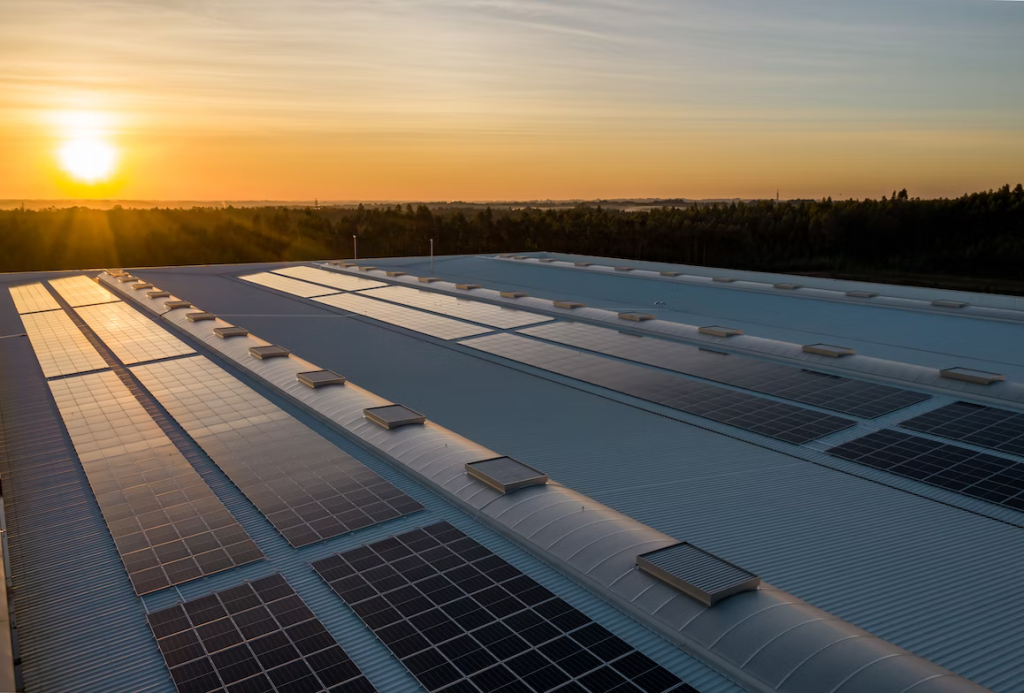Taking advantage of the sun’s energy has become increasingly crucial as we work to slow global warming. Popular methods of transforming solar energy into usable electricity include the use of solar panels. One way they generate electricity is by letting photons (individual particles of light) dislodge electrons from atoms.
Nevertheless, the question remains, how does this occur in practice? This article will delve into the mechanics of solar panels and describe the process of how current travels inside them.
Solar Panel: What Is It?
Solar panels, also known as photovoltaic (PV) panels, are used to generate electricity from the sunshine. Solar cells, which can be created from semiconductor materials like silicon, are its building blocks. Sunlight excites electrons in a solar panel’s semiconductor material, which then move about and generate a current when they hit a metal contact.

To build a solar array, solar panels are modular and can be linked to one another. The size and power output of a solar panel or array will be affected by variables such as the number of solar cells it contains, the efficiency of those cells, and the amount of sunshine it gets.
Solar panels generate zero pollutants or emissions when they are used to generate electricity. Since the price of production has dropped and as governments have enacted policies to promote the adoption of renewable energy, their use has increased in recent years. They have several potential uses, from supplying electricity to homes and businesses to bringing power to locations without access to grid-based electricity.
How Does Current Flow In A Solar Panel?
Solar panels are effective because they use the photovoltaic effect to transform solar energy into usable electricity. As photons of light hit the surface of a solar cell, the energy is transferred to electrons in the semiconductor material, which then travels and generates an electric current.
Anti-reflective coating on top, metal connections in the middle, semiconductor material (often silicon) at the bottom, and a rear contact layer complete the fundamental construction of a solar panel. Solar panels work by allowing sunlight to enter the semiconductor material below the anti-reflective coating.
In a semiconductor, photons excite electrons, forcing them to transition from the valence band to the conduction band. These stray electrons are collected by the metal contacts on either side of the semiconductor material and sent further to an external circuit, where they can be used to power a device.
Many sorts of things, from individual electronics to huge buildings, can be powered by this current. A solar panel’s output current will be affected by many variables, including the intensity of sunlight striking the panel, the quality of the solar cells, and the panel’s or array’s size and layout. As a whole, solar panels are a clean and renewable energy option because they produce no harmful byproducts when they are turned on.
Solar Panel: Pros And Cons
Although the solar panel has many advantages as a sustainable energy source, they do have some drawbacks as well. Some of the primary benefits and drawbacks of solar panels are as follows:
Pros:
Renewable And Clean Energy
Solar panels generate electricity from the sun’s energy, which is a renewable and clean source of energy. They do not produce any emissions or pollution during operation. Clean energy comes from resources that can be regenerated naturally and don’t contribute to pollution or emissions when they’re used.
These renewable energy options are preferred because they are less harmful to the environment than coal, oil, and natural gas, which are nonrenewable resources that add to global warming because of the greenhouse gases they release.
Renewable and clean energy sources include the sun, the wind, the water, the earth’s geothermal heat, and organic matter like biomass. Combinations of these energy types are common because they can offer stable and long-lasting power to households, companies, and factories.
Cost-Effective In The Long Run
While the initial cost of installing solar panels can be expensive, they can ultimately save you money on your electricity bills over the long run. Once the panels are installed, you can generate your electricity for free, which can significantly reduce your monthly bills.
Because they can lessen or even do away with electricity expenses altogether, solar panels can be a good long-term investment. Solar panel installation might be expensive, but once the system is up and running, it can provide free electricity for decades.
With a 25-30 year lifespan and low maintenance needs, solar panels are a great long-term investment. It’s more cost-effective than other options because the upfront cost can be deducted from the total over time.
Low-Maintenance
Solar panels require minimal maintenance, as they have no moving parts and are designed to withstand harsh weather conditions. Solar panels’ cheap upkeep is one of their main selling points. After installation, solar panels rarely need maintenance because there are no moving parts. With less frequent upkeep, solar panels become a less labour-intensive way to generate electricity.
Even with occasional damage from things like rain, snow, and hail, solar panels are built to survive for 25-30 years with very little upkeep. Cleaning and inspecting solar panels are the primary forms of upkeep.
Flexible Applications
Solar panels can be used in a variety of applications, from powering small electronics to providing electricity to homes and businesses. They are also useful in remote areas where traditional power sources are not available. Solar panels are a flexible choice for electricity generation because they are a multipurpose technology with many uses.
Providing power to homes and businesses is one of the most prevalent uses for solar panels. Installation of solar panels on roofs or in open areas can create electricity that can be used to run home electronics, street lights, and other electrical necessities.
Cons:
High Initial Cost
The initial cost of installing solar panels can be high, which can make them difficult to afford for some homeowners and businesses. Solar panels have a high entry price because of how difficult they are to set up. Solar panels have the potential to reduce electricity costs over time, but installing them can be expensive upfront.
The price of solar panels changes with the area in which they are installed and the size of the system being installed. A larger system will often have a greater installation cost. In addition, local factors, such as labour prices, building requirements, and permit fees, might all add up to make installation more expensive in some regions than in others.
Weather Dependent
Solar panels rely on sunlight to generate electricity, which means that they are less effective on cloudy or overcast days. They may also produce less electricity during the winter months when there are fewer hours of daylight. The fact that solar panels require sunny days to function is another disadvantage.
A solar panel system’s ability to create electricity is proportional to the amount of sunshine it gets; hence, the amount of electricity generated on cloudy or gloomy days will be lower than on bright days.
So, areas with a lot of foggy days might not benefit as much from solar panels. Wind and hydropower may be more efficient renewable energy sources in certain regions.
Land Use
Solar panels require significant land use, as they need to be installed in large arrays to generate enough electricity to be useful on a large scale. This can be a concern in areas where land use is already limited. The fact that solar panels require sunny days to function is another disadvantage.
A solar panel system’s ability to create electricity is proportional to the amount of sunshine it gets; hence, the amount of electricity generated on cloudy or gloomy days will be lower than on bright days.
So, areas with a lot of foggy days might not benefit as much from solar panels. Wind and hydropower may be more efficient renewable energy sources in certain regions.
Energy Storage
Solar panels only generate electricity during the day, which means that energy storage systems such as batteries are needed to store excess energy for use at night or on cloudy days. These energy storage systems can be expensive and require maintenance.
The need for a reliable means of storing solar energy is a major factor in the technology’s overall cost. As the name implies, solar panels only produce electricity during the day when the sun is shining. The availability of electricity necessitates the use of energy storage.
Batteries are widely used as solar panels’ means of storing energy for later use. Excess energy produced throughout the day can be stored in these batteries and used later, even when there is not as much sunlight. Technology advancements have made batteries a practical option for power storage because they are now more efficient and cheaper than before.
Conclusion
Solar panels are a promising renewable energy source due to their many advantages, including their low initial cost, low maintenance requirements, a wide range of possible uses, and rising efficiency. Yet, much like every other energy source, solar panels have their downsides, including hefty upfront expenditures, reliance on favourable weather conditions, space and land needs, and the need for energy storage.
However, technological advancements and the creation of novel solutions are overcoming these obstacles, making solar energy a more practical alternative for individuals, corporations, and governments seeking to lessen their impact on the environment and the planet by producing clean, renewable energy.
Solar panels are anticipated to play a significant part in providing for our long-term energy demands if they are properly funded and developed.
Thinking of going solar? SolarFlow is the best choice for you!
